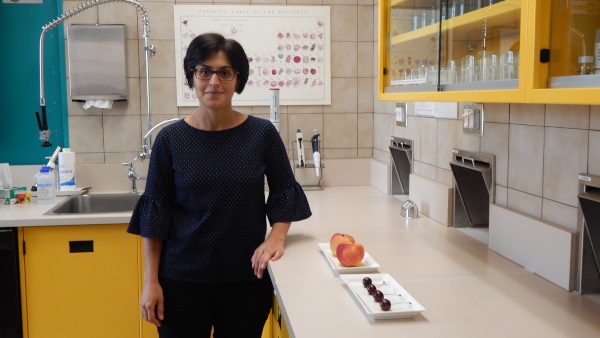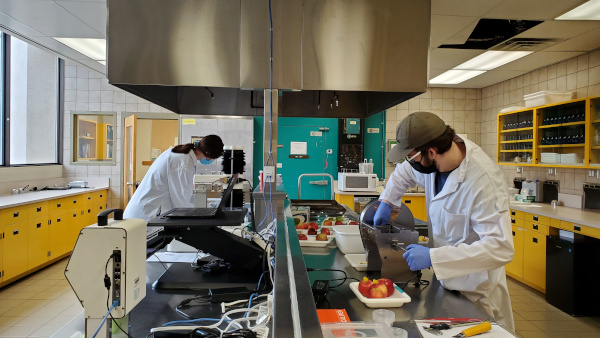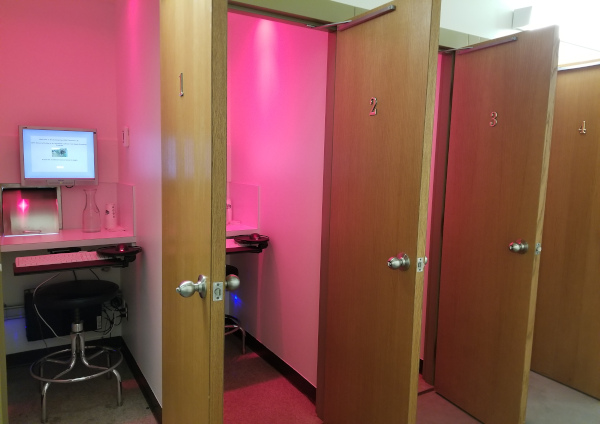Media Relations
Agriculture and Agri-Food Canada
1-866-345-7972
aafc.mediarelations-relationsmedias.aac@agr.gc.ca
Do you have a favourite apple? Whether it's a sweet Ambrosia or a tangy Salish, there's an apple for just about anyone, and we have science to thank for that. The wide variety of fruits available to us on the market today are made possible through scientific breeding. However, this doesn't happen overnight, and it can take more than 25 years before a new variety reaches the grocery stores! With such a lengthy process, scientists want to be certain that the new variety will appeal to the market.
We use all of our senses when we eat an apple. We see the colour and shape, taste the flavour, touch and feel the texture and might even hear a crisp-like sound as we bite into it. Textural properties – crispness, hardness, juiciness and skin toughness – in particular play a key role in influencing our perception and appeal. Researchers at Agriculture and Agri-Food Canada (AAFC) harness this information through sensory evaluation and other consumer research methods to determine which new fruit varieties will be successful on the market.
Sensory evaluations traditionally rely on trained panellists to examine the properties of a food through the human senses. Under this method, panelists are placed in individual booths and receive unmarked samples to assess. Although given the high volume of sensory evaluations needed on a daily basis, this method can become both time consuming and expensive.
There are several instruments available with the potential to measure textural properties, but these measurements don't provide any tangible insights on their own. In other words, what do these measurements mean in relation to human perception? Dr. Masoumeh Bejaei and her team at AAFC's Summerland Research and Development Centre (RDC) in the Okanagan Valley of British Columbia have identified a simple solution to help researchers and industry utilize these instruments to measure and replicate human perception of an apple.
Corresponding measurements with human perception
Dr. Bejaei and her team set out to assess two commercially available instruments – the Mohr Digei-Test-2 and the TA.XTplus Texture Analyzer. Trained panellists were involved to provide traditional evaluations as a scale of reference. First, the team identified and interpreted instrumental measurements that can be obtained from each device. After that, they conducted the tests and mapped each apple variety based on its textural profile using both the instrumental and sensory data.
Dr. Bejaei's team was able to classify apple varieties into four texture groups – soft flesh with tough skin; soft flesh with thin to moderate skin toughness; moderate flesh hardness and skin toughness; and hard flesh with moderate skin toughness. Then, models were developed to correlate measurements with human perception of fruit crispness and hardness with more than 85% accuracy, and skin toughness and juiciness with around 50% accuracy.
"Without validated models to guide us, we may be measuring something that doesn't actually mean anything to the consumer."
- Dr. Masoumeh Bejaei, Research Scientist, Agriculture and Agri-Food Canada
For the industry, these easy-to-use models will help identify improved production, storage and handling practices without the need for time consuming and expensive traditional sensory panels at each stage. Producers will be able to count on simple and reliable tools to conduct quality assessments at any stage of the production process, assessing the impact each practice has on the sensory characteristics of their fruit.
Key Discoveries/Benefits
- Sensory evaluations help scientists identify desirable qualities for new varieties, but since apple breeding programs require a high-volume of evaluations daily, this can be time consuming and expensive.
- Dr. Masoumeh Bejaei and her team have developed models that can correlate instrumental measurements of textural attributes in apples to human perception.
- These easy-to-use models will allow scientists and industry to conduct sensory evaluations with simple and reliable tools, saving time and cost.
Photo gallery

Dr. Masoumeh Bejaei stands beside apple and cherry samples at the Summerland Research and Development Centre.

Summerland's sensory research team conducts instrumental measurements on apple samples.

Panel rooms used for traditional methods of sensory evaluation at Summerland research centre in British Columbia.
Related information
- Selecting Apples with Better Texture More Quickly
- Modelling and classification of apple textural attributes using sensory, instrumental, and compositional analyses
- Summerland Research and Development Centre
- Masoumeh Bejaei, Ph.D.
- Comparing apples to apples: Karen Burgher's fruit sensory evaluation program adapts to a virtual world